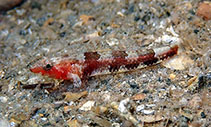| Family: |
Gobiidae (Gobies), subfamily: Gobionellinae |
| Max. size: |
2.44 cm SL (male/unsexed); 2.72 cm SL (female) |
| Environment: |
benthopelagic; marine; depth range 46 - 69 m |
| Distribution: |
Mediterranean Sea: Spain (Balearic Islands). |
| Diagnosis: |
Dorsal spines (total): 7-7; Dorsal soft rays (total): 6-7; Anal spines: 1-1; Anal soft rays: 6-7. This species is distinguished by the following characters: preopercular head canal present with pores ?, ?, ?; ( snout long, equal or longer than eye, 1.0-1.1 in eye length, with dorsal profile of snout gently sloping; lower lip ends anteriorly slightly in front of upper lip; scales in lateral series 28- 29; scales in transverse series 6; head length as percentage of standard length: 28.7-30.0% in adults, 32.2% in juvenile; greatest body depth, measured at the pelvic fin origin as percentage of standard length: 15.0-16.8%; eye diameter, measured as percentage of standard length: 6.9-7.7%; Colouration of adult female: head and body to pectoral and pelvic fins orange reddish, the rest of body whitish transparent with a dark reticulate pattern and small amount of orange red pigment; the fins mostly transparent and only partially pigmented; and, caudal peduncle at caudal fin base with a dark orange vertical band (Ref. 125634). |
| Biology: |
Individuals were collected from sampling stations located on red algae beds, which is one of the most widespread types of habitats of the shallow continental shelf of the Balearic Islands at depths between 50 and 80 meters. The sampling stations have very similar epibenthic communities in which predominant algae species on the basal stratum belong to the families Corallinaceae (with Lithothamnion corallioides, Lithothamnion valens, Phymatolithon calcareum and Spongites fruticolus among the most abundant) and to Peyssonneliacea (with Peyssonnelia rubra and Peyssonnelia inamoena among the most abundant), and on the erect stratum to Phyllophoraceae (with Phyllophora crispa). With Peyssonnelia spp. having a high biomass, the sampling stations can be classified as Peyssonnelia beds, a frequently occurring habitat in the south west of Mallorca, and the south of Menorca. These beds are frequently associated with open bays characterized by fine sediments, even mud, where calm periods alternate with periods of eddy forming currents. Speleogobius llorios was found in a sheltered area, without significant currents (Ref. 125634). |
| IUCN Red List Status: |
Not Evaluated (N.E.) Ref. (130435)
|
| Threat to humans: |
harmless |
Source and more info: www.fishbase.org. For personal, classroom, and other internal use only. Not for publication.
